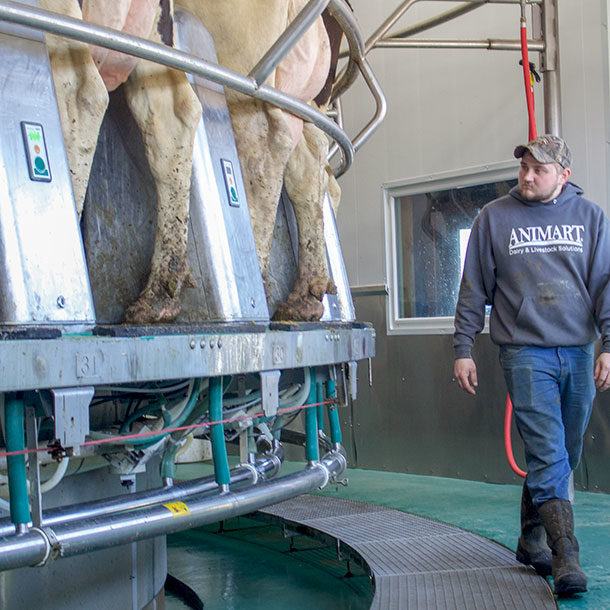The most expensive asset on a dairy is the milking system. Therefore, many producers focus on making the parlor or automated milking system as efficient as possible. Recent technological advances and the adoption of in-line sensors have made managing the milking system much easier. Two of the most valuable pieces of information that we receive from milking system data are milking duration – the total unit-on time for a cow – and milking speed – the cow's rate of milking in pounds per minute.
Milking speed and duration are somewhat related. Speed can impact overall milking time. On average, cows with higher milking speeds tend to have shorter milking durations. However, many studies have examined milking duration throughout the lactation and found that average milking duration closely follows the shape of the lactation curve. This suggests that milk yield has more of an impact on duration than milking speed.
Both milking duration and speed can tell us a lot about milking procedures, parlor efficiency and their impact on potential milk yield and quality. Milking procedures in the parlor can impact milking speed (flow) and milking duration.
Milking prep and milking duration
Most dairy cows have a milking duration between four and seven minutes. When it comes to practices we can control, proper lag or stimulation time is one of the most important factors that can impact duration. Having too short or too long of lag times can hinder milk letdown. The goal of lag time is to ensure oxytocin has reached the mammary gland and is ejecting milk from the alveoli by the time the milking unit is attached. The failure to capture milk letdown will lead to bimodal milkings – a lag before letdown. Bimodal milking can add two or more minutes to the total milking time.
Milking prep and milking speed
Cows generally reach peak milk flow within the first minute or two of attaching the milking unit. At peak milking speed, milk flow rates average between 8 and 10 pounds per minute. The time to peak milk flow increases when optimal lag times are not reached. Evaluating milking speeds throughout the duration can help determine if milking prep times and stimulation are inadequate. If milking speeds are below 6 pounds of milk per minute within 30 to 60 seconds of unit attachment, a bimodal milking is likely to occur.
Takeoff setting and milking duration
Regarding milk system settings, takeoff settings are probably the most impactful on milking duration. Most systems recommend detachment at a milk flow rate of less than 2 pounds per minute. Often, adjustments are made to make the milking duration shorter. Increasing the takeoff settings by 1 pound per minute can decrease the unit-on time by up to two minutes. A shorter milking duration can lead to a more efficient parlor because more cows are milked in less time. Making small changes over time is key to changing takeoff settings.
Residual milk and teat health
Changing takeoff settings often leads to the question of how much milk is OK to walk out of the parlor. The concern is that if takeoff settings are too wet – i.e., more milk left in the udder after milking – we may increase somatic cell counts (SCC). Research examining the effect of residual milk-on-milk quality has yielded mixed results. Some studies have shown an increase in SCC, while others have shown no difference. Most recent studies have recommended a threshold of 1.7 cups or 1.8 pounds of residual milk in the mammary gland after the completion of milking.
Another concern is that if takeoff settings are too dry, it may cause damage to the teat end. Drier takeoff settings lead to longer unit-on times. Takeoff settings can also impact the average claw vacuum. With longer milking durations, average milking speeds tend to decrease. The decrease in milk flow rates will cause the average claw vacuum during milking to increase. Combining longer milking duration and increased claw vacuum may lead to poor teat-end health.
Combining speed and duration to make decisions
Improving parlor efficiency can be done by evaluating milking speed and duration. Milking speeds can tell us a lot about whether milking procedures are being done correctly. If milking speeds are low (less than 6 pounds per minute) within the first 30 seconds to a minute of unit attachment, we are likely experiencing bimodal milking. Using milking speeds as a benchmarking tool can help determine when it may be time to retrain milking procedures.
Changing takeoff settings is one of the most impactful ways to decrease milking duration. Changes should be made gradually. Individual cow SCC can change rapidly. Calculating rates of new subclinical and clinical mastitis cases may be a more effective way to determine the impact on milk quality. Teat-end and congestion scores should also be evaluated to see if modifications should be made. Some studies have shown that combining milk flow rates and maximum milk times (five to seven minutes) can lead to more efficiency. A goal of 20% to 30% of cows reaching a maximum milk time has shown to be a positive benchmark.
Using milking duration data to make cow grouping decisions can also be beneficial. Farms that have grouped slow-milking cows (less than seven minutes) have seen parlor efficiency increase by up to 30%.
Many benchmarks for milking speed and duration exist. However, these thresholds need to be specific to individual farm goals. Striving for higher milking speeds and shorter durations can make milking systems more efficient, but we do not want efficiency to hinder production, quality or animal health.










